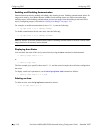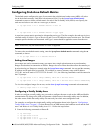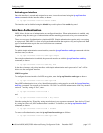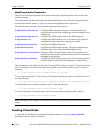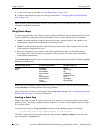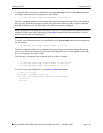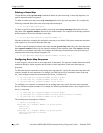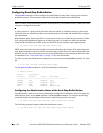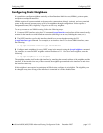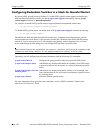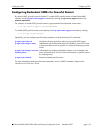
Configuring OSPF Configuring OSPF
page 1-26 OmniSwitch 6800/6850/9000 Advanced Routing Configuration Guide December 2007
Deleting a Route Map
Use the no form of the ip route-map command to delete an entire route map, a route map sequence, or a
specific statement within a sequence.
To delete an entire route map, enter no ip route-map followed by the route map name. For example, the
following command deletes the entire route map named redistipv4:
-> no ip route-map redistipv4
To delete a specific sequence number within a route map, enter no ip route-map followed by the route
map name, then sequence-number followed by the actual number. For example, the following command
deletes sequence 10 from the redistipv4 route map:
-> no ip route-map redistipv4 sequence-number 10
Note that in the above example, the redistripv4 route map is not deleted. Only those statements associated
with sequence 10 are removed from the route map.
To delete a specific statement within a route map, enter no ip route-map followed by the route map name,
then sequence-number followed by the sequence number for the statement, then either match or set and
the match or set parameter and value. For example, the following command deletes only the match tag 8
statement from route map redistipv4 sequence 10:
-> no ip route-map redistipv4 sequence-number 10 match tag 8
Configuring Route Map Sequences
A route map may consist of one or more sequences of statements. The sequence number determines which
statements belong to which sequence and the order in which sequences for the same route map are
processed.
To add match and set statements to an existing route map sequence, specify the same route map name and
sequence number for each statement. For example, the following series of commands creates route map
rm_1 and configures match and set statements for the rm_1 sequence 10:
-> ip route-map rm_1 sequence-number 10 action permit
-> ip route-map rm_1 sequence-number 10 match tag 8
-> ip route-map rm_1 sequence-number 10 set metric 1
To configure a new sequence of statements for an existing route map, specify the same route map name
but use a different sequence number. For example, the following command creates a new sequence 20 for
the rm_1 route map:
-> ip route-map rm_1 sequence-number 20 action permit
-> ip route-map rm_1 sequence-number 20 match ipv4-interface to-finance
-> ip route-map rm_1 sequence-number 20 set metric 5
The resulting route map appears as follows:
-> show ip route-map rm_1
Route Map: rm_1 Sequence Number: 10 Action permit
match tag 8
set metric 1
Route Map: rm_1 Sequence Number: 20 Action permit
match ip6 interface to-finance
set metric 5



